Is Your Car’s Air Suspension System Failing? Key Signs and Solutions
Posted on September 19, 2025
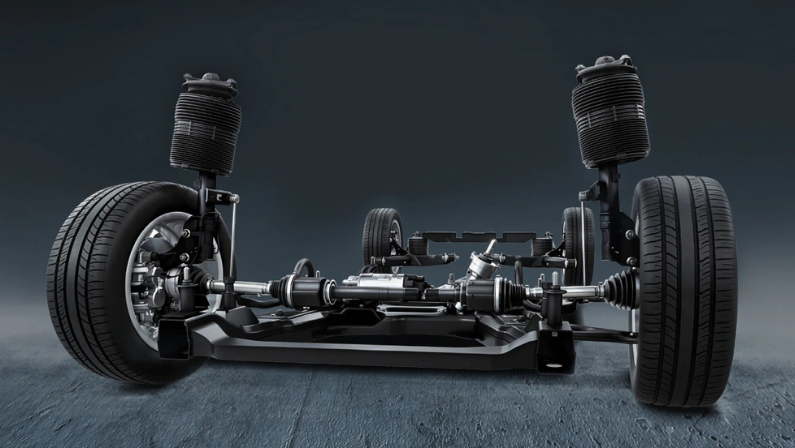
If your luxury SUV or truck suddenly rides like a wagon—sagging unevenly, bouncing excessively, or refusing to maintain height—your air suspension system might be failing.
Unlike conventional steel springs, these systems use pressurized air springs to deliver unmatched comfort and adjustability. But when components wear out, the results can range from annoying to dangerous.
At CarHub North York Chrysler, we’ve seen firsthand how air suspension issues disrupt driving confidence. In this guide, we’ll cover:
- How air suspension works
- Top warning signs of a failing system (e.g., compressor noise, leaks, or warning lights)
- Critical fixes to avoid costly repairs down the road
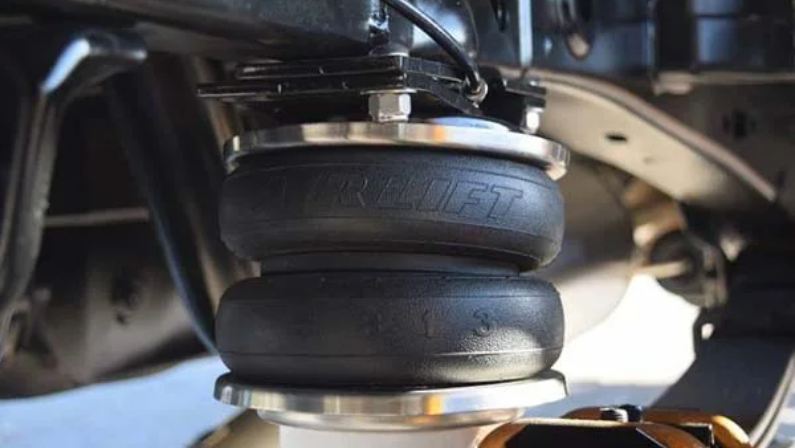
What Is Air Suspension?
Air suspension is a modern system that replaces traditional metal springs with air-filled springs to support your vehicle.
It uses a control module to manage ride height and comfort by adjusting the amount of air in the springs based on factors like speed, load, and road conditions. This system helps the car stay level and smooth, even when carrying heavy cargo or driving over bumps.
The system works through a network of valves, air compressors, and sensors. Valves open and close to let compressed air in or out of the springs, allowing the car to raise or lower itself.
For example, the vehicle might lower at high speeds for better handling and fuel efficiency or raise for more ground clearance on rough terrain. Overall, air suspension offers a smoother ride and better adaptability than traditional suspension setups.
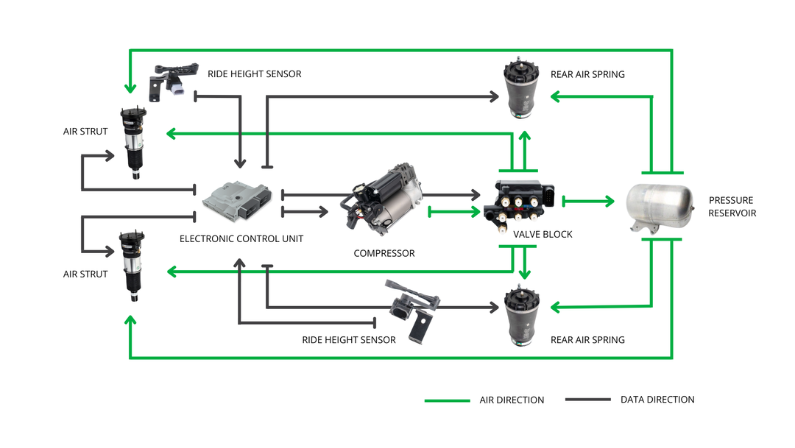
Components of an Air Suspension Vehicle System
To understand how an air suspension system works, it helps to know the key parts that make it work. Each component plays an important role in keeping your ride smooth, stable, and at the right height.
Below is a breakdown of the main parts that make up a typical air suspension system and what each one does.
1. Air Springs/Air Bags
Air springs, also known as air bags, are the core of the air suspension system. These flexible rubber bags use air pressure to absorb shocks and keep the ride smooth.
They can be found on all four corners of the vehicle, depending on the system design. Because they are constantly under pressure, they are prone to wear and air leaks over time and should be inspected regularly.
2. Air Compressor
The air compressor is responsible for pumping air into the air springs. It maintains the correct pressure to ensure optimal ride height and comfort. If the compressor fails (often due to overheating or poor maintenance), you may notice the car sagging or riding unevenly.
3. Air Lines
Air lines carry compressed air from the compressor to the air springs and other parts of the system. These thin tubes must be kept in good condition to avoid air leaks or clogs, which can affect the entire suspension system’s performance.
4. Solenoid Valves
Solenoid valves manage how much air flows to and from the air springs. They open or close based on signals from the control unit or driver settings. If these valves malfunction, the system won’t be able to adjust the ride height properly.
5. Height Sensors
Height sensors monitor the distance between the vehicle's body and wheels. Based on this information, the system adjusts the air pressure in the springs to maintain a balanced ride. A faulty height sensor can lead to uneven suspension or a lopsided vehicle.
6. Electronic Control Unit (ECU)
The ECU acts as the brain of the air suspension system. It receives data from sensors and controls the compressor, solenoid valves, and air distribution. A malfunctioning ECU can throw off the entire system, leading to inconsistent ride height and performance.
7. Reservoir
The air reservoir stores excess compressed air from the compressor, ensuring there's a steady supply when needed. It helps the system respond faster to changes in ride height. Regular checks are important to ensure it remains airtight and free of blockages.
8. Struts/Dampers
Struts and dampers work alongside air springs to smooth out bumps and maintain handling. They absorb shocks from the road, especially during turns and sudden stops. Like traditional suspension parts, they can wear out and may need realignment or replacement.
9. Control Module
The control module is the driver's interface with the air suspension system. It allows manual adjustments to the ride height or comfort settings, depending on the vehicle. Keeping the module in working order is essential for driver control and system accuracy.
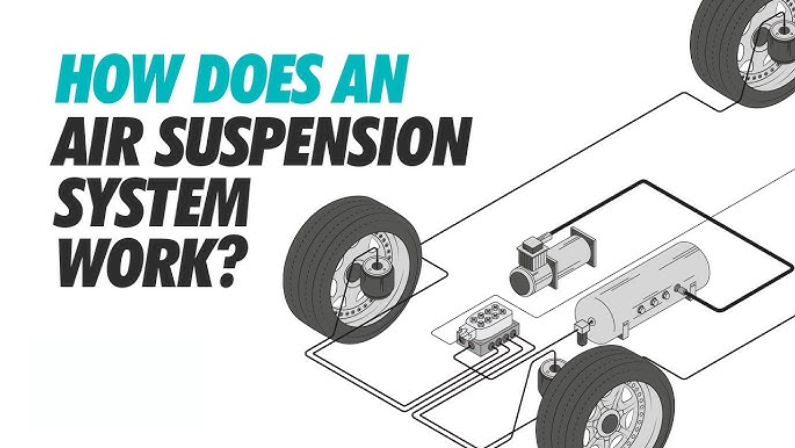
How Does an Air Suspension System Work?
An air suspension system replaces traditional steel springs with air-filled springs to support the vehicle. It uses an onboard air compressor to pump air into the air springs, helping to smooth out bumps and maintain the desired ride height.
Air lines carry the compressed air from the compressor to each spring, while solenoid valves control where the air goes.
As you drive, the system monitors conditions and adjusts air levels by opening or closing the solenoids. This allows the vehicle to automatically or manually adjust its height and ride quality.
By inflating or deflating the air springs, the system can raise the vehicle for more clearance or lower it for better handling and comfort.
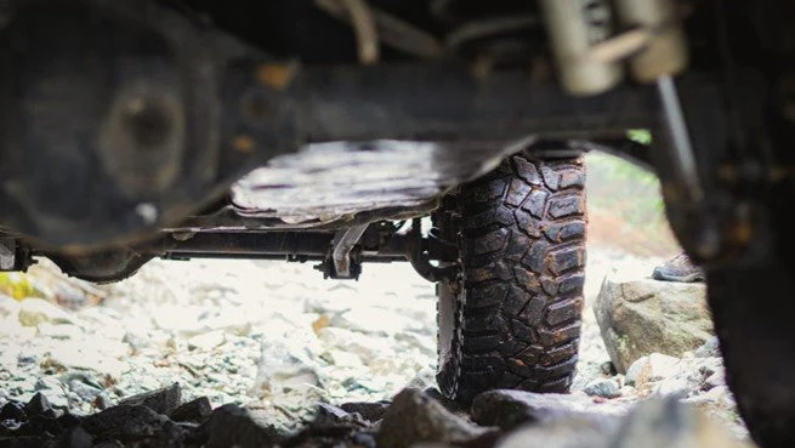
What are the Advantages of Air Suspension?
Air suspension offers several key benefits that improve both comfort and performance while driving.
1. Comfort
One of the biggest advantages of air suspension is the smooth ride. It absorbs bumps and potholes better than traditional systems, making driving more comfortable for both the driver and passengers.
2. Adjustability
Air suspension lets you change the ride height and firmness depending on your needs. You can raise the vehicle for off-road driving or lower it on highways to improve fuel efficiency and handling. Some systems even adjust automatically based on speed or road conditions.
3. Longer Component Life
Because air suspension distributes weight and road forces more evenly, it helps reduce strain on parts like shocks, brakes, and steering components. This can lead to longer-lasting vehicle parts and fewer repairs over time.
4. Better Handling and Cornering
The system adjusts to changes in weight distribution, helping to keep the vehicle level during turns or when carrying uneven loads. This improves stability and reduces body lean when cornering.
5. Great for Towing
For trucks and SUVs, air suspension helps prevent the rear from sagging under heavy loads. It keeps the vehicle level, which improves safety, reduces wear on other parts, and helps with fuel efficiency.
6. Versatility
Air suspension systems are flexible and can easily switch between different driving modes, like towing a trailer or driving with passengers, making them ideal for a variety of uses.
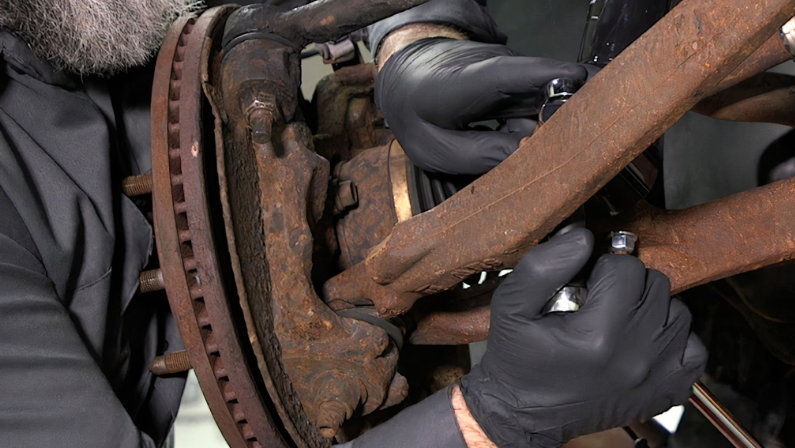
Common Problems with the Air Suspension System
Like any vehicle component, air suspension systems can develop issues over time.
Here are some of the most common problems that affect performance and ride quality:
1. Air Leaks
Air leaks are the most common issue in air suspension systems. They often occur in air springs or air lines and can lead to a noticeable drop in ride height or uneven suspension. A hissing sound, visible damage, or bubbles in the air lines can help identify a leak.
2. Air Pump Issues
If the air pump struggles to inflate the air springs or makes unusual noises, it could indicate a problem. A weak or malfunctioning pump will affect the system’s ability to maintain proper height and comfort.
3. Faulty Compressor
A failing compressor can’t supply enough air to keep the system pressurized. This often results in a sagging suspension, a rough ride, or the system being stuck at one height. Loud noises or no response when adjusting the suspension are warning signs.
4. Worn or Damaged Air Springs
Air springs wear out over time, especially in harsh weather or under heavy loads. Cracks, dry rot, or physical damage can lead to air leaks and a bumpy ride. Regular inspection is key to catching this issue early.
5. Faulty Height Sensors
When height sensors malfunction, the system can't accurately measure or adjust the ride height. This can cause the car to sit too high or too low or change height unevenly. Error codes or sudden changes in height are common symptoms.
6. Bad Solenoid Valves
Solenoid valves control airflow in the system. If they fail, the system may not inflate or deflate the air springs properly, causing inconsistent ride height and poor handling. Noisy or stuck valves are a common sign.
7. Electronic Control Unit (ECU) Problems
The ECU manages all the components of the air suspension system. If it fails, the entire system can behave erratically or stop working. ECU issues often trigger dashboard warnings or result in suspension that won’t respond to commands.
8. Blockage in Air Lines
Dirt or moisture in the air lines can block airflow to the springs. This causes uneven suspension, slow height adjustments, or failure to maintain proper pressure. Blockages need to be cleared to restore normal function.
9. System Inconsistency
When multiple parts fail or don’t communicate properly (like sensors, valves, or the ECU), the result is inconsistent performance. You might experience a vehicle that doesn’t stay level, changes height unpredictably, or delivers an uncomfortable ride. Prompt diagnosis and repair are crucial to prevent further damage.
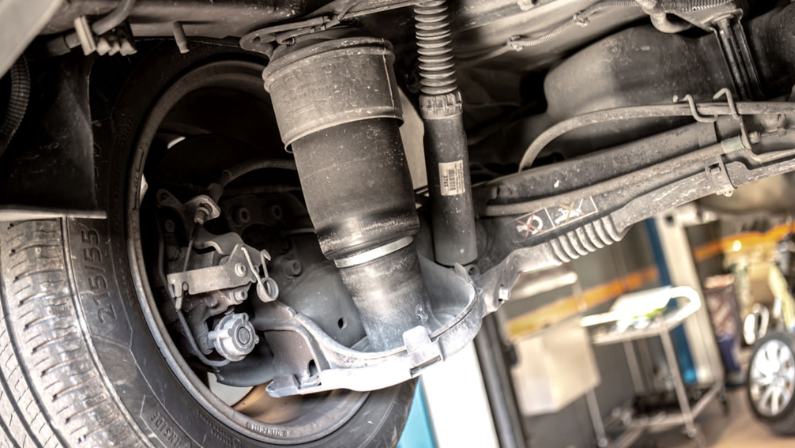
Symptoms of a Bad Air Suspension System
A failing air suspension system can affect your vehicle’s comfort, safety, and overall performance. Recognizing the warning signs early can help prevent further damage and costly repairs.
Here are the most common symptoms to watch out for:
1. Uneven Ride Height
If one corner or side of your vehicle sits lower than the rest, it usually indicates a problem with the air springs, height sensors, or a leak in the system. This is one of the most noticeable signs that something is wrong.
2. Poor Ride Quality
An air suspension system is designed to provide a smooth, cushioned ride. If you start to feel every bump or dip in the road, it may mean the air springs or dampers aren’t functioning properly.
3. Bumpy or Uncomfortable Ride
When air springs lose pressure or fail entirely, they can’t absorb road impact as intended. This often results in a stiff or jarring ride, making driving uncomfortable.
4. Sagging Suspension When Parked
If your vehicle slowly sags to one side after being parked for a while, it could indicate a slow air leak in one or more air springs. This is especially common when the vehicle appears fine while driving but sinks overnight.
5. Poor Handling or Swaying
Difficulty steering, excessive body roll in corners, or feeling like the vehicle is swaying on turns can all signal a suspension problem. This affects stability and is dangerous during emergency maneuvers.
6. Loud or Constant Compressor Noise
A properly working air compressor should run quietly and infrequently. If it’s noisy or running constantly, it could be overcompensating for a leak or failing component.
7. Warning Lights on the Dashboard
Modern vehicles with air suspension systems will often alert the driver through a dashboard warning light or message (e.g., “Stop – car too low”). You may also see the check engine light, depending on the issue. A scan tool can help diagnose specific error codes.
8. Unusual Vehicle Behavior
Signs such as bouncing, swaying, or tilting can indicate an issue with the suspension. These behaviors not only reduce comfort but also affect your ability to control the vehicle safely.
9. Increased Fuel Consumption
If your air suspension isn’t maintaining proper ride height, especially if the vehicle rides too low, it can increase drag and reduce fuel efficiency over time.
10. Visible Damage to Suspension Components
Cracks, dry rot, or visible wear on air bags or struts may point to a larger issue in the system. Any signs of physical damage should be addressed immediately.
If you notice any of these symptoms, it's best to have your air suspension system inspected by a qualified technician. Catching the problem early can save you from more extensive damage and higher repair costs later on.
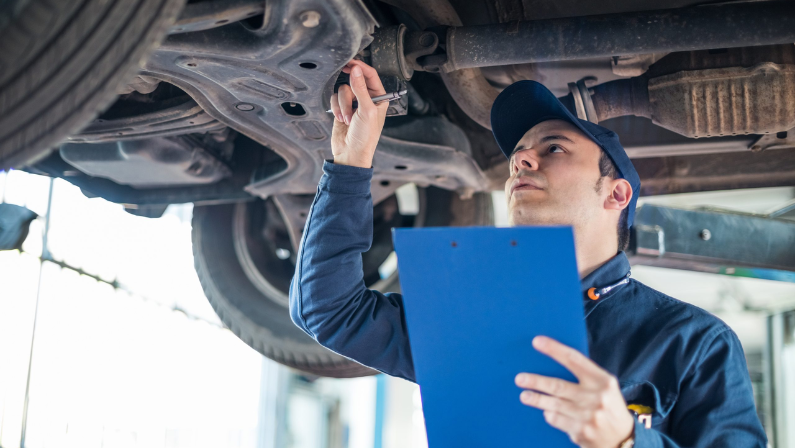
How to Diagnose Air Suspension Problems
If your vehicle isn’t riding as smoothly as it should or you're noticing odd behavior, it could be a sign of air suspension trouble.
Here are a few simple ways to diagnose potential issues:
1. Check for Visible Leaks
Start by inspecting each air spring and air line for any signs of damage, cracks, or holes. You can spray a soapy water solution on the suspected areas. If you see bubbles forming, that’s a strong indicator of an air leak that needs repair.
2. Listen to the Compressor
Pay attention to how often the air compressor turns on. If it's running more frequently than usual or making loud or unusual noises, it could mean there's a leak in the system or the compressor is struggling to maintain pressure. A constantly running compressor is often a sign of a deeper issue and may be close to failure.
3. Inspect the Control Module and Sensors
If your vehicle is adjusting ride height erratically or not responding to manual changes, there may be a problem with the control module or one of the height sensors. Using a diagnostic scan tool can help determine if any of these components are sending faulty signals or have stopped working entirely.
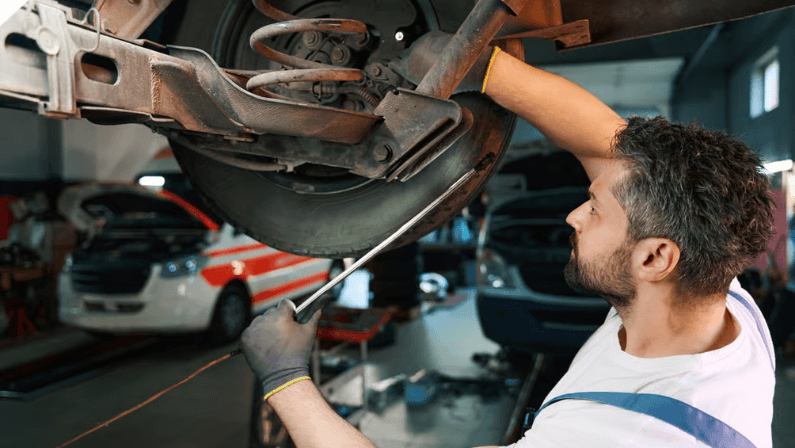
How to Fix Air Suspension Problems
Once you’ve identified the problem with your air suspension system, the next step is to make the necessary repairs.
Here are some common solutions based on the issue:
1. Replace Worn Air Springs
If your air springs are leaking, cracked, or no longer holding pressure, it’s best to replace them. High-quality replacement air springs are widely available and can restore ride comfort while helping prevent further damage to the system.
2. Repair or Replace the Compressor
If the compressor is noisy, slow to respond, or not working at all, it may need repair or full replacement. Before installing a new compressor, make sure to fix any air leaks in the system - otherwise, the new unit may overwork and fail prematurely.
3. Reset or Replace Faulty Sensors
If the ride height seems off or the vehicle is adjusting unevenly, the issue may lie with a faulty height sensor. Some sensors can be reset or recalibrated, but in many cases, replacement is necessary to ensure accurate readings and smooth system operation.
4. Address Control Module Issues
When the control module malfunctions, it can cause inconsistent ride height or failure to adjust the suspension properly. In these cases, reprogramming the module or replacing it entirely can restore normal system function and improve reliability.
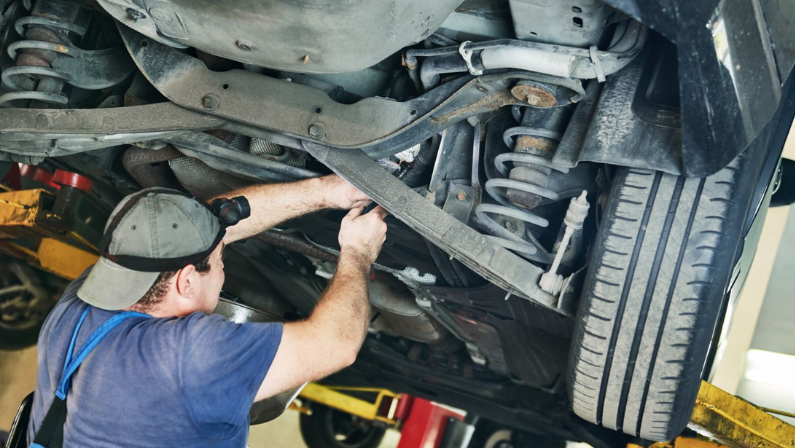
How to Prevent Air Suspension Problems
Preventing issues with your air suspension system mainly comes down to good care and mindful driving habits.
Here are some key tips to help keep your suspension in top shape:
1. Regular Maintenance and Inspections
Routine check-ups with a trusted mechanic are essential. Regular maintenance allows professionals to spot early signs of wear or leaks in components like the compressor, air springs, or sensors.
Catching small problems early means you can fix them before they become costly repairs or cause complete system failure.
2. Driving Habits
Avoiding rough, uneven, or debris-filled roads can significantly reduce the stress on your air suspension system. Driving mostly on smooth, well-maintained roads helps prevent excessive wear and tear on the air springs and related parts.
Being gentle with your vehicle, especially over bumps and potholes, can extend the life of your suspension.
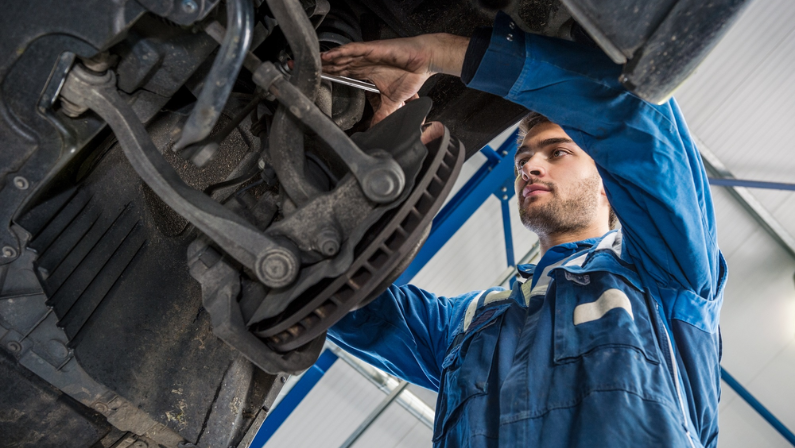
Don't Let Air Suspension Problems Ruin Your Ride
A failing air suspension system does more than just compromise comfort; it puts your vehicle's safety and performance at risk! If you're noticing the common symptoms mentioned in this blog, addressing these issues early can save you from costly repairs and keep your luxury SUV or truck riding as smoothly as it should.
Why Trust the Experts at CarHub North York Chrysler?
- Advanced diagnostics to pinpoint leaks, compressor issues, or electrical faults
- Genuine OEM parts for lasting repairs
Schedule your inspection today or call 1 (877) 849-8734. Serving Toronto drivers with expert care for over 15 years—let us restore your ride's premium comfort!
